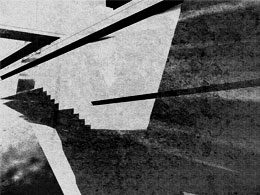STUDENTS PROJECTS
PROJECTS2015
Student: Mitrou Nikolina
Supervisor: Athanasios Spanomaridis, Vasilis Pappas
University of Patras, Architecture Department
Date of Presentation: November 2015
sculpture, slit, journey, narrative, garden
Recognizing the city as a sculpture and creating a new landscape that communes with water, are defined mentally and perceptually through a new architectural vocabulary that reproduces the way of perception of the Japanese garden.
The waterways in Tokyo embody the ancient past, however today they are abandoned and degraded. Rivers and canals represent urban boundaries, a kind of intermediate, hybrid and public space. Kanda river, one of the most extensive and vital rivers in Tokyo, was used, historically, as the first drinking water transportation system for the palace.
The recognition of the water element appear as a crack of the urban sculpture, the research of the current situation and the vision of regaining the public landscape and the restoration of the relationship with water, are studied in three scales.
RECOGNITION
The study area, north and south of Kanda river, is a node of contact of four individual centers of Japanese capital and is characterized by:
- High density of the urban infrastructure
- -Strong physical relief and many water elements
- Important landmarks of the city and large accumulation areas
- Advanced and extensive transport system


On a strip scale the cultural elements are recorded on either side of the water, the dynamics and problems of the relationship between crack and city. There is a distinct non-immediate accessibility to water, as two very strict limits, train and road, evolve linearly in both sides. The meeting of indeterminate continuous urban ridge with the water limit, the topography and the presence of the train emphasize the dynamic elements of the landscape.
The strip is divided into four cognitive areas where bipolar contrasts identified between city and water.


THE VISION
The Japanese garden is experienced through the human gaze and body. All of the elements compose a representation of the natural world. Immobility, contemplation, frame, proportions, symbolism, time transformations, all function as individual features in the management of static scene. The walk composes the spatial narrative.
The urban landscape is recreated based on the principles of the Japanese garden. These, like water and soil, emerge, crystallize and weave local culture in Tokyo.

A zigzag path follows the natural topography of the land, as it emerges and sinks. The narrative is intended the habitation of landscape and unfolds as a series of space experiences.
The small harbor, introduces the stranger the narrative.
The oasis ark, is immersed in natural rock, like a sandpit. Its front, communes with water and interacts with the opposite train station. The ark of knowledge, hosts a library for students of the neighboring colleges.
Contemplation. The narrative projects a part of the building, where forms are framed from the distant landscape.
The eternal vlysis, is created at this point. The arrangement has a dual significance. On the city level, where river water is still not visible, the eternal vlysis acts as a passage, a kind of preparation and spiritual purification for the stranger to confront the river. The tank gushes and recycles water as a waterfall, completing the view of the garden.
The pure land and the dilemma. The place of infinite light and eternal life is the residence of Amida Buddha and expresses the heavenly existence of the garden. The city meets the pure land and three possible paths bear the stranger with the feeling of dilemma.
Bridging the slit. The bridge in garden marks a limit and a transition to a sacred place. Indoor, the traditional shakkei technique is used, the technique of the borrowed landscape. The space hosts sculptures and paintings.
The garden of shade in the city front creates an urban entry.
The gates of the dragon. The gate Torii, as an imitation of the symbol of the bridge, and is used as a transition from the public to the sanctuary and isolation. Reproduction is a statement of tiered uninterrupted transition from the city, directly on the water.
Moon-viewing platform. The grand staircase, displays a platform for contemplation of the moon.
Sinking and rising. The third linear volume, attempts to give a sense of sinking and rising, following the natural topography. Two opposing auditoriums are created.
The urban courtyard. At the endpoint of the walk, is the courtyard of the city. A node, a hug, a decision made by the stranger of the story... whether to continue this journey...



The comparison of garden and urban landscape could be a strategy to synthesize extensive parts of the city, along the river. The 'crystallized narrative' is reproduced, highlighting the dynamic contrasts of the existing landscape and creating a new revelation trip.
In urban scale a narrative network of the local history is created, by linking landmarks and their connection with the water.
Revival: level near the water. An undulating route follows the river flow of Nihonbashi, reviving its historical use as a connector between Kanda river and palace.
Sinking: hidden paths, below ground level. The experience of sinking is characterized by intense emotional swings.
Familiarity: city level. Linear paths highlight the physiognomy of the city as a commercial neighborhood.
Disclosure: Overhead routes. The stranger perceives the sculpture on a scale of supervision and guidance, approaching the water.


The proposal is intended to define the natural fluid limit in a constantly changing urban landscape. Modern architecture is required to produce a new vocabulary, which is incompatible with the form. The culture is woven through the search of the spirituality, which connects cosmos and humans, nature, culture and religion, heritage and contemporary Architectural Act.
The face of Japan
Text: Part of Nikos Kazantzakis book, titled: Travelling: Japan - China
Music: Shigeru Umebayashi - Yumeji's theme - In the mood for love (2000)












